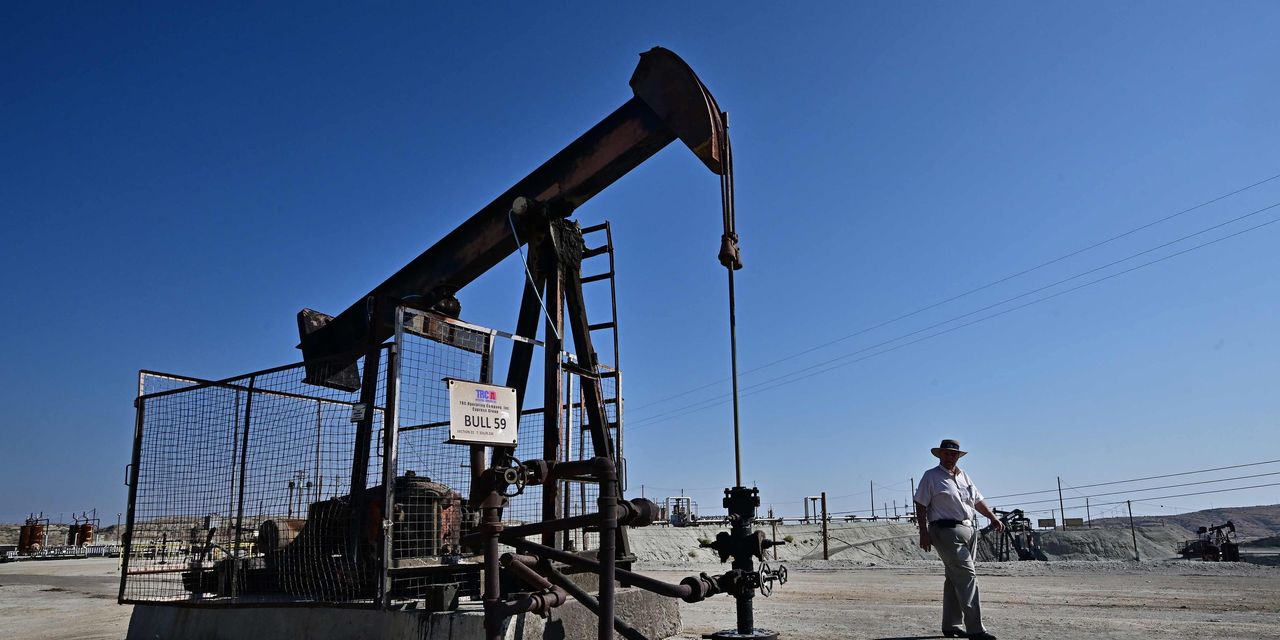Oil futures on Thursday marked another finish at their lowest since august, a day after data showing a large increase in U.S. gasoline inventories sparked the biggest one-day selloff of 2023.
Price action
-
West Texas Intermediate crude for November delivery
CL00,
+0.61% CL.1,
+0.61% CLX23,
+0.61%
fell $1.91, or 2.3%, to settle at $82.31 a barrel on the New York Mercantile Exchange, the lowest front-month contract finish since Aug. 30, according to Dow Jones Market Data. -
December Brent crude
BRN00,
-0.18% BRNZ23,
-0.18% ,
the global benchmark, lost $1.74, or 2%, at $84.07 a barrel on ICE Futures Europe, the lowest since Aug. 24. Both WTI and Brent plunged 5.6% in the previous session. -
November gasoline
RBX23,
+0.06%
edged down by 0.4% to $2.19 a gallon, while November heating oil
HOX23,
+1.38%
shed 4.9% to $2.87 a gallon. -
November natural gas
NGX23,
+5.18%
settled at $3.17 per million British thermal units, up 6.9%.
Market drivers
Oil prices in September had marked a fourth straight month of gains, offering a “good time to book profit off the table,” Naeem Aslam, chief investment officer at Zaye Capital Markets, told MarketWatch.
“The bears have odds on their side as traders have started to pay attention to the brewing trouble in the Treasury yields,” which indicates higher interest rates from the Federal Reserve and potential of lower economic growth, he said.
Crude tumbled Wednesday after the Energy Information Administration reported that U.S. gasoline inventories climbed by 6.5 million barrels in the week ended Sept. 29. Analysts surveyed by S&P Global Commodity Insights, on average, had looked for an unchanged figure.
After the steep drop in oil prices Wednesday, Tariq Zahir, managing member at Tyche Capital Advisors, said he believed the losses present another entry point for investors, “with production cuts still happening and the market still in a backwardation posture.” Backwardation refers to a situation in crude contract values where prices for oil for delivery in the near future are higher than those for later deliveries.
Still, in its report Wednesday, the EIA said motor gasoline product supplied, a proxy for demand, averaged 8.3 million barrels a day over the last four-week period. That’s down 5% from the same period last year.
Read: Demand destruction sinks oil prices as gasoline inventories send warning signal
“Gasoline inventory builds have spilled over into crude markets amid concerns about a potential 2024 recession driven by rising interest rates and caused a shift in the crude futures curve that has negatively impacted prompt crude prices,” Stephen Innes, managing partner at SPI Asset Management, said in a note.
Analysts said a buildup in speculative long positions as WTI and Brent pushed above $90 a barrel last month also set the stage for a violent round of profit-taking.
Commodity Futures Trading Commission data last week showed net long positions in WTI futures had moved to a 22-month high of 314,519 contracts, noted Robert Yawger, executive director for energy futures at Mizuho Securities.
Long position holders are in “semi-panic mode here, with WTI down over 10% in the five days since trading to a one-year high of $95.05 on Sept. 28,” he said.
Meanwhile, there are some reports that say Saudi Arabia has raised its official selling prices to Asia for a fifth month in a row, said Phil Flynn, senior market analyst at The Price Futures Group.
“That’s despite the fact that oil prices have tanked [and] more than likely suggests that Saudi Arabia is confident about oil demand in Asia,” he told MarketWatch.
Also on Thursday, natural-gas futures rallied after the EIA reported that U.S. natural-gas supplies in storage rose by 86 billion cubic feet for the week ended Sept. 29.
On average, analysts surveyed by S&P Global Commodity Insights forecast an increase of 91 billion cubic feet.
“Production weakness from pipeline maintenance and an expected boost to heating demand from below-average temperatures in the Northeast and Eastern Midwest this week create some upside risk in the near term,” said Victoria Dircksen, commodity analyst at Schneider Electric, in a daily note. However, “mild temperature forecasts for late October suggest more bearish momentum to come.”
Read the full article here











